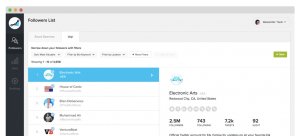
300% growth in 15 months – it sounds like a pipe dream for most marketing and sales leaders, but for Snowflake, a cloud data warehousing company based in San Mateo, it was reality. That’s rocketship growth if I’ve ever seen it!
The company is known as one of the hottest growth brands in Silicon Valley, their rapid ascent most recently marked by a $ 450M fund in October, 2018 led by Sequoia Capital. With steady growth to-date and marquee customers such as Netflix, Office Depot, DoorDash, Netgear, Ebates and Yamaha, it’s no wonder why the business was ripe for additional funding.
But, it was Snowflake’s ability to scale Marketing and Sales to meet aggressive growth goals that gave them the leverage they needed to secure funding for additional growth and globalization.
There were three key components of their Sales and Marketing foundation:
1 – Focus on Key Accounts
In business-to-business (B2B) deals, companies sell to accounts, not single buyers. Gartner research found on average, 12 to 14 individuals participate in larger technology purchases, like that of Snowflake’s cloud data warehousing services.
As many high-performing B2B organizations have done, the company adopted an Account Based Marketing (ABM) strategy in order to focus time and resources on high-value, good-fit target accounts. This allowed Snowflake’s Marketing team to drive larger deals (and better economies of scale) by focusing on the same prioritized list of accounts that Sales was focused on.
To build that target list, the company’s Marketing team worked with Sales to define their Ideal Customer Profile (ICP), a set of criteria that helps to refine a universe of possible targets down to only those that are most likely to buy, and drive strong lifetime value. This collaboration was important, as it ensured buy-in from both teams.
Many teams wonder how to build a list of target accounts. Building an ICP as Snowflake did comes down to answering a few critical questions:
- What sector(s) are you winning in?
- What “lookalike” segments are similar to those you’re having success with now?
- What new markets are most important for your company to develop? Are they growing?
- What accounts will deliver the most value in the form of strategic value, advocacy, referrals, or geographic presence?
2 – Intelligence and Measurement at the Account Level
With the target account list identified, a key factor in the success of this initiative was the unique way in which Snowflake approached measurement to align with this account focus.
Coverage
The company first needed to understand its account coverage, or how many viable contacts for these target accounts existed in their marketable database. Lead records are historically owned by marketing, and do not roll up to accounts in most CRM systems. This divide is also reflected in the current marketing automation systems. The risk of un-matched contacts manifests itself in incorrect routing, scoring, a disruption to the customer’s experience, and poor reporting.
To bridge this gap, Snowflake deployed lead-to-account matching technology within their CRM database to understand which individual contacts belonged to which target accounts.
Engagement
The company also implemented measurement that focused on account engagement tracking – in other words, how all potential buyers at target accounts interacted with both Marketing and Sales touches. Engagement is a key for teams like Snowflake’s to measure, as it indicates that prospects and customers are more committed to the relationship. It also shows increasing likelihood to purchase, renew, or advocate.
Snowflake shares this intelligence across the entire revenue team for a common perspective on how an account is performing. This has helped the team warm up new territories when the revenue team identifies trending engagement, as they continued to hire Sales representatives against their aggressive growth targets. By accelerating the ramp-up of these new sales hires and new territories, Snowflake successfully expanded their global sales team by 4X with fast and efficient ramp periods.
Today, with visibility on current engagement levels and account progression, Snowflake’s target accounts are demonstrating more than 15 engaged people across the business.
3 – Tiering Accounts and Prioritizing Accordingly
The final piece to Snowflake’s success was the understanding that all target accounts are not created equal, and prioritizing accordingly.
The firm supports 3,000 target accounts with a single ABM program manager who sits on the Marketing team, and 30 sales reps.
Their key to this type of scale and efficiently is tiering. Rather than try to treat all 3,000 accounts equally with the same messaging, campaigns, or resource allocation, Snowflake identified 300 “tier 1” accounts, with the rest assigned to “tier 2.”
Tier 1 accounts get bespoke attention, fully customized plans, and deep research – after all, these accounts represent the highest potential value to the business. The ABM program manager works closely with Sales in ABM standups to tailor key messages, and deliver highly customized 1:1 programs (one person on Snowflake’s team engaging with one person on the target account’s team) for each of the rep’s top 10 accounts. These efforts could span channels such as ads, direct mail, live events, and more.
The team uses orchestration to automate interactions across these multiple channels.
Tier 2 accounts don’t get completely customized marketing plays and content, but they still get highly relevant touches based on their industry and persona. Instead of 1:1 programs, these accounts get 1:few campaigns, such as Snowflake’s “Data Warehouse Modernization” campaign designed to shift companies from legacy to cloud-based infrastructure.
This creative content-based sales play provides 1-pagers that directly speak to the challenges buyers face in this scenario. This type of highly defined, yet programmatic, play has allowed Snowflake to be successful at operationalizing and delivering ABM at scale and achieve rocketship growth.
Note: All accounts are managed in Engagio, so that the Marketing team is not spending hours pulling numbers together from multiple systems.
Thanks to the combination of these efforts, Snowflake realized 300% growth in 15 months, far exceeding any original goals they set. They were able to implement a high-functioning ABM program that scaled pipeline in a repeatable and predictable motion, helping them to raise $ 450 million to fund additional growth across the globe.
This is a trajectory we’re confident they’ll exceed thanks largely in part to the strong Sales and Marketing foundations in place.
Business & Finance Articles on Business 2 Community
(65)
Report Post





